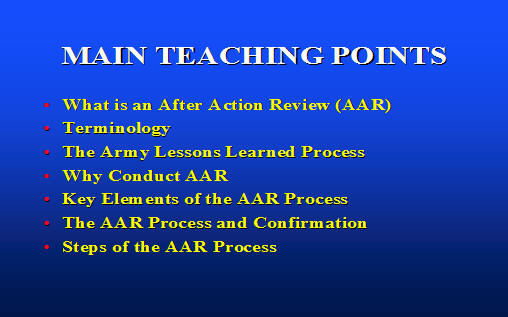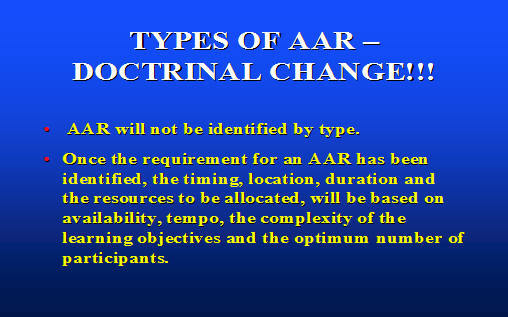THE AFTER ACTION REVIEW PROCESS
Click here to download the presentation.



THE AFTER ACTION REVIEW PROCESS
DOCTRINE
Major R. Kennedy
AIM
MAIN TEACHING POINTS
What is an After Action Review (AAR)
Terminology
The Army Lessons Learned Process
Why Conduct AAR
Key Elements of the AAR Process
The AAR Process and Confirmation
Steps of the AAR Process
REFERENCES
Annex E to the Army Strategic Planning Process – “The Army Lessons Learned Process”
CFP 300-8, “Training Canada’s Army, Chapter 7
After Action Review Aide-Memoire
TERMINOLOGY
Critique – The critique is characterized by mainly one-way flow of feedback about an individual’s or team’s performance. While the participants will often be offered the opportunity to identify their own strengths and weaknesses, it is clearly understood that the senior person involved in the critique stands ready to fill in any gaps . The critique’s only advantages are that it takes less time to conduct and is useful when the participant’s ability to analyze their own performance may be limited due to inexperience. Critiques should be the exception rather than the norm.
TERMINOLOGY
Debrief – The process of retrieving information from returning patrols and aircrew. Also used commonly in the Army to describe the process of providing feedback to an individual or a team about their performance. This term and critique are interchangeable.
Hot Wash-up – The “quick and dirty” attempt after a training event to capture lessons. Normally does not allocate sufficient time or resources to permit a focussed discussion of what happened, why it happened and how to improve.
THE ARMY LESSONS LEARNED PROCESS
MAJOR ACTIVITIES – ALLP
Determine Information Requirements (Lessons) for Future Activities
Collect, Analyze, Develop Lessons and Coordinate Staff Action
Provide Direction to Assimilate Lessons Into Doctrine, Trg, Acquisition of Equipment, etc Archive and Disseminate Lessons, Provide Feedback, Follow-up
Incorporate Existing Lessons Into Planning for New Activities
THE AFTER ACTION REVIEW PROCESS
It is the process by which After Action Reviews are planned, prepared, conducted and followed-up. Its intent is to allow the participants of a training event or an operation to QUICKLY and CONSISTENTLY LEARN the most from their experiences.
WHAT IS AN AFTER ACTION REVIEW?
TYPES OF AAR – DOCTRINAL CHANGE!!!
AAR will not be identified by type.
Once the requirement for an AAR has been identified, the timing, location, duration and the resources to be allocated, will be based on availability, tempo, the complexity of the learning objectives and the optimum number of participants.
WHY CONDUCT AAR?
LEARN MORE FROM OUR TRAINING
LEARN TO LEARN FROM EXPERIENCE
IN OUR BUSINESS, WE DON’T ALWAYS GET A SECOND CHANCE TO LEARN!!!
KEY ELEMENTS
TIMELY FEEDBACK. Troops need feedback as soon as possible so that they can begin using that information to begin learning and improving. The more objective and accurate the feedback, the easier it is for them to determine what happened and why it happened (ground truth).
FACTORS EFFECTING TIMELY FEEDBACK
Tempo. When is the right time to pause to provide feedback?
Source. The more objective the source, the more readily the soldiers and the team will accept the feedback. Potential sources include:
Chain of command
Observer/Controllers
OPFOR
Weapons Effects Simulation and audio-visual equipment
FACTORS EFFECTING TIMELY FEEDBACK
Opportunity to utilize the feedback to improve. If no time or resources are allocated to make use of the feedback, then it will be wasted.
KEY ELEMENTS
ACTIVE PARTICIPATION. People learn more quickly when they are actively involved in identifying their own problems and developing their own solutions. In order for active participation to occur, time must be available and the participation must be encouraged.
An atmosphere must exist within the team that encourages active participation. If team members believe that their input is not welcome, will not be acted upon or that “disagreement equals disloyalty,” then it will be difficult to generate active participation.
WAYS TO ENCOURAGE ACTIVE PARTICIPATION
Make sure there is lots of time for discussion
Include as many members from the team in the AAR as possible.
Ask open ended questions
Share the discussion time
Let the team do the talking. If the Observer/Controller is talking more than the team members, its probably a critique, not an AAR!
KEY ELEMENTS cont’d
FOCUSSED DISCUSSION. The discussion must be focussed on what happened, why it happened and how to improve. The AAR must focus on solutions, not just problems. Improvements must be based on doctrine.
WAYS TO FOCUS THE DISCUSSION
Avoid using the question “So, how did you think that went?” Use a key event and look at what happened, why it happened and how to improve
Orient the discussion to their application of doctrine to the tactical situation
Keep the discussion focused on the team’s performance, not that of others
KEY ELEMENTS
FOLLOW-UP. The participants must be provided with the opportunity to put the solutions that they have developed into practice so they can demonstrate to themselves and their chain of command that they have learned and improved. This builds confidence and team cohesion.
THE AAR AND CONFIRMATION??
The AAR and confirmation are EXCLUSIVE activities.
Active participation will not occur if the participants feel that their remarks will be used against them or their leaders.
If the intent is to learn from a confirmation event as well as to assign a grade or mark, the grade or mark will be assigned prior to the start of the AAR.
THE AFTER ACTION REVIEW PROCESS
AFTER ACTION REVIEW
DEMONSTRATION